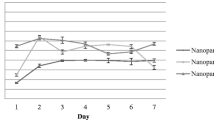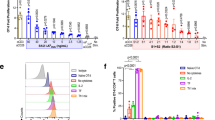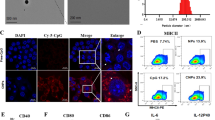Abstract
Protein antigen (Ag)-based immunotherapies have the advantage to induce T cells with a potentially broad repertoire of specificities. However, soluble protein Ag is generally poorly cross-presented in MHC class I molecules and not efficient in inducing robust cytotoxic CD8+ T cell responses. In the present study, we have applied poly(lactic-co-glycolic acid) (PLGA) nanoparticles (NP) which strongly improve protein Ag presentation by dendritic cells (DC) in the absence of additional Toll-like receptor ligands or targeting devices. Protein Ag-loaded DC were used as antigen presenting cells to stimulate T cells in vitro and subsequently analyzed in vivo for their anti-tumor effect via adoptive transfer, a treatment strategy widely studied in clinical trials as a therapy against various malignancies. In a direct comparison with soluble protein Ag, we show that DC presentation of protein encapsulated in plain PLGA-NP results in efficient activation of CD4+ and CD8+ T cells as reflected by high numbers of activated CD69+ and CD25+, interferon (IFN)-γ and interleukin (IL)-2-producing T cells. Adoptive transfer of PLGA-NP-activated CD8+ T cells in tumor-bearing mice displayed good in vivo expansion capacity, potent Ag-specific cytotoxicity and IFN-γ cytokine production, resulting in curing mice with established tumors. We conclude that delivery of protein Ag through encapsulation in plain PLGA-NP is a very efficient and simple procedure to stimulate potent anti-tumor T cells.





Similar content being viewed by others
References
Banchereau J, Steinman RM (1998) Dendritic cells and the control of immunity. Nature 392(6673):245–252
Melief CJ (2008) Cancer immunotherapy by dendritic cells. Immunity 29(3):372–383
Steinman RM, Hemmi H (2006) Dendritic cells: translating innate to adaptive immunity. Curr Top Microbiol Immunol 311:17–58
Petersen TR, Dickgreber N, Hermans IF (2010) Tumor antigen presentation by dendritic cells. Crit Rev Immunol 30(4):345–386
Kawakami Y, Eliyahu S, Delgado CH, Robbins PF, Sakaguchi K, Appella E, Yannelli JR, Adema GJ, Miki T, Rosenberg SA (1994) Identification of a human melanoma antigen recognized by tumor-infiltrating lymphocytes associated with in vivo tumor rejection. Proc Natl Acad Sci USA 91(14):6458–6462
Ossendorp F, Mengede E, Camps M, Filius R, Melief CJ (1998) Specific T helper cell requirement for optimal induction of cytotoxic T lymphocytes against major histocompatibility complex class II negative tumors. J Exp Med 187(5):693–702
Schoenberger SP, Toes RE, van der Voort EI, Offringa R, Melief CJ (1998) T-cell help for cytotoxic T lymphocytes is mediated by CD40-CD40L interactions. Nature 393(6684):480–483
Blachere NE, Morris HK, Braun D, Saklani H, Di Santo JP, Darnell RB, Albert ML (2006) IL-2 is required for the activation of memory CD8 + T cells via antigen cross-presentation. J Immunol 176(12):7288–7300
Keene JA, Forman J (1982) Helper activity is required for the in vivo generation of cytotoxic T lymphocytes. J Exp Med 155(3):768–782
Mischo A, Bubel N, Cebon JS, Samaras P, Petrausch U, Stenner-Liewen F, Schaefer NG, Kubuschok B, Renner C, Wadle A (2011) Recombinant NY-ESO-1 protein with ISCOMATRIX adjuvant induces broad antibody responses in humans, a RAYS-based analysis. Int J Oncol 39(1):287–294
Sang M, Lian Y, Zhou X, Shan B (2011) MAGE-A family: attractive targets for cancer immunotherapy. Vaccine 29(47):8496–8500
Zandvliet ML, van Liempt E, Jedema I, Veltrop-Duits LA, Willemze R, Guchelaar HJ, Falkenburg JH, Meij P (2010) Co-ordinated isolation of CD8(+) and CD4(+) T cells recognizing a broad repertoire of cytomegalovirus pp 65 and IE1 epitopes for highly specific adoptive immunotherapy. Cytotherapy 12(7):933–944
Zhang H, Hong H, Li D, Ma S, Di Y, Stoten A, Di Haig N, Gleria K, Yu Z, Xu XN, McMichael A, Jiang S (2009) Comparing pooled peptides with intact protein for accessing cross-presentation pathways for protective CD8 + and CD4 + T cells. J Biol Chem 284(14):9184–9191
Newman KD, Samuel J, Kwon G (1998) Ovalbumin peptide encapsulated in poly(d, l lactic-co-glycolic acid) microspheres is capable of inducing a T helper type 1 immune response. J Control Release 54(1):49–59
Waeckerle-Men Y, Gander B, Groettrup M (2005) Delivery of tumor antigens to dendritic cells using biodegradable microspheres. Methods Mol Med 109:35–46
Zhang Z, Tongchusak S, Mizukami Y, Kang YJ, Ioji T, Touma M, Reinhold B, Keskin DB, Reinherz EL, Sasada T (2011) Induction of anti-tumor cytotoxic T cell responses through PLGA-nanoparticle mediated antigen delivery. Biomaterials 32(14):3666–3678
Gilding DK, Reed AM (1979) Biodegradable polymers for use in surgery—polyglycolic/poly(lactic acid) homo- and copolymers: 1. Polymer 20(12):1459–1464
Mahapatro A, Singh DK (2011) Biodegradable nanoparticles are excellent vehicle for site directed in vivo delivery of drugs and vaccines. J Nanobiotechnol 9:55
Jain AK, Das M, Swarnakar NK, Jain S (2011) Engineered PLGA nanoparticles: an emerging delivery tool in cancer therapeutics. Crit Rev Ther Drug Carr Syst 28(1):1–45
Hamdy S, Haddadi A, Hung RW, Lavasanifar A (2011) Targeting dendritic cells with nano-particulate PLGA cancer vaccine formulations. Adv Drug Deliv Rev 63(10–11):943–955
Shen H, Ackerman AL, Cody V, Giodini A, Hinson ER, Cresswell P, Edelson RL, Saltzman WM, Hanlon DJ (2006) Enhanced and prolonged cross-presentation following endosomal escape of exogenous antigens encapsulated in biodegradable nanoparticles. Immunology 117(1):78–88
Schlosser E, Mueller M, Fischer S, Basta S, Busch DH, Gander B, Groettrup M (2008) TLR ligands and antigen need to be coencapsulated into the same biodegradable microsphere for the generation of potent cytotoxic T lymphocyte responses. Vaccine 26(13):1626–1637
Demento SL, Eisenbarth SC, Foellmer HG, Platt C, Caplan MJ, Mark Saltzman W, Mellman I, Ledizet M, Fikrig E, Flavell RA, Fahmy TM (2009) Inflammasome-activating nanoparticles as modular systems for optimizing vaccine efficacy. Vaccine 27(23):3013–3021
Yoshida M, Mata J, Babensee JE (2007) Effect of poly(lactic-co-glycolic acid) contact on maturation of murine bone marrow-derived dendritic cells. J Biomed Mater Res A 80(1):7–12
Han H, Peng JR, Chen PC, Gong L, Qiao SS, Wang WZ, Cui ZQ, Yu X, Wei YH, Leng XS (2011) A novel system of artificial antigen-presenting cells efficiently stimulates Flu peptide-specific cytotoxic T cells in vitro. Biochem Biophys Res Commun 411(3):530–535
Steenblock ER, Fahmy TM (2008) A comprehensive platform for ex vivo T-cell expansion based on biodegradable polymeric artificial antigen-presenting cells. Mol Ther 16(4):765–772
Palucka K, Banchereau J (2012) Cancer immunotherapy via dendritic cells. Nat Rev Cancer 12(4):265–277
Steinman RM (2012) Decisions about dendritic cells: past, present, and future. Annu Rev Immunol 30:1–22
Rosenberg SA, Dudley ME (2009) Adoptive cell therapy for the treatment of patients with metastatic melanoma. Curr Opin Immunol 21(2):233–240
Restifo NP, Dudley ME, Rosenberg SA (2012) Adoptive immunotherapy for cancer: harnessing the T cell response. Nat Rev Immunol 12(4):269–281
Winzler C, Rovere P, Rescigno M, Granucci F, Penna G, Adorini L, Zimmermann VS, Davoust J, Ricciardi-Castagnoli P (1997) Maturation stages of mouse dendritic cells in growth factor-dependent long-term cultures. J Exp Med 185(2):317–328
Schuurhuis DH, Ioan-Facsinay A, Nagelkerken B, van Schip JJ, Sedlik C, Melief CJ, Verbeek JS, Ossendorp F (2002) Antigen-antibody immune complexes empower dendritic cells to efficiently prime specific CD8 + CTL responses in vivo. J Immunol 168(5):2240–2246
Sanderson S, Shastri N (1994) LacZ inducible, antigen/MHC-specific T cell hybrids. Int Immunol 6(3):369–376
Moore MW, Carbone FR, Bevan MJ (1988) Introduction of soluble protein into the class I pathway of antigen processing and presentation. Cell 54(6):777–785
Slutter B, Bal S, Keijzer C, Mallants R, Hagenaars N, Que I, Kaijzel E, van Eden W, Augustijns P, Lowik C, Bouwstra J, Broere F, Jiskoot W (2010) Nasal vaccination with N-trimethyl chitosan and PLGA based nanoparticles: nanoparticle characteristics determine quality and strength of the antibody response in mice against the encapsulated antigen. Vaccine 28(38):6282–6291
Hamdy S, Haddadi A, Shayeganpour A, Samuel J, Lavasanifar A (2011) Activation of antigen-specific T cell-responses by mannan-decorated PLGA nanoparticles. Pharm Res 28(9):2288–2301
Mueller M, Schlosser E, Gander B, Groettrup M (2011) Tumor eradication by immunotherapy with biodegradable PLGA microspheres—an alternative to incomplete Freund’s adjuvant. Int J Cancer 129(2):407–416
Tacken PJ, Zeelenberg IS, Cruz LJ, van Hout-Kuijer MA, van de Glind G, Fokkink RG, Lambeck AJ, Figdor CG (2011) Targeted delivery of TLR ligands to human and mouse dendritic cells strongly enhances adjuvanticity. Blood 118(26):6836–6844
Klebanoff CA, Gattinoni L, Palmer DC, Muranski P, Ji Y, Hinrichs CS, Borman ZA, Kerkar SP, Scott CD, Finkelstein SE, Rosenberg SA, Restifo NP (2011) Determinants of successful CD8 + T-cell adoptive immunotherapy for large established tumors in mice. Clin Cancer Res 17(16):5343–5352
Montagna D, Turin I, Schiavo R, Montini E, Zaffaroni N, Villa R, Secondino S, Schiavetto I, Caliogna L, Locatelli F, Libri V, Pession A, Tonelli R, Maccario R, Siena S, Pedrazzoli P (2012) Feasibility and safety of adoptive immunotherapy with ex vivo-generated autologous, cytotoxic T lymphocytes in patients with solid tumor. Cytotherapy. 14(1):80–90
Boyman O, Sprent J (2012) The role of interleukin-2 during homeostasis and activation of the immune system. Nat Rev Immunol 12(3):180–190
Boyman O, Purton JF, Surh CD, Sprent J (2007) Cytokines and T-cell homeostasis. Curr Opin Immunol 19(3):320–326
Denoeud J, Moser M (2011) Role of CD27/CD70 pathway of activation in immunity and tolerance. J Leukoc Biol 89(2):195–203
Gerdes N, Zirlik A (2011) Co-stimulatory molecules in and beyond co-stimulation—tipping the balance in atherosclerosis? Thromb Haemost 106(5):804–813
Schreiber TH, Wolf D, Bodero M, Gonzalez L, Podack ER (2012) T cell costimulation by TNFR superfamily (TNFRSF)4 and TNFRSF25 in the context of vaccination. J Immunol 189(7):3311–3318
Trinchieri G (2003) Interleukin-12 and the regulation of innate resistance and adaptive immunity. Nat Rev Immunol 3(2):133–146
Turtle CJ, Riddell SR (2010) Artificial antigen-presenting cells for use in adoptive immunotherapy. Cancer J 16(4):374–381
Gattinoni L, Powell DJ Jr, Rosenberg SA, Restifo NP (2006) Adoptive immunotherapy for cancer: building on success. Nat Rev Immunol 6(5):383–393
Dudley ME, Wunderlich JR, Shelton TE, Even J, Rosenberg SA (2003) Generation of tumor-infiltrating lymphocyte cultures for use in adoptive transfer therapy for melanoma patients. J Immunother 26(4):332–342
Ho WY, Nguyen HN, Wolfl M, Kuball J, Greenberg PD (2006) In vitro methods for generating CD8 + T-cell clones for immunotherapy from the naive repertoire. J Immunol Methods 310(1–2):40–52
Le HK, Graham L, Miller CH, Kmieciak M, Manjili MH, Bear HD (2009) Incubation of antigen-sensitized T lymphocytes activated with bryostatin 1 + ionomycin in IL-7 + IL-15 increases yield of cells capable of inducing regression of melanoma metastases compared to culture in IL-2. Cancer Immunol Immunother 58(10):1565–1576
Budd RC (2001) Activation-induced cell death. Curr Opin Immunol 13(3):356–362
Green DR, Droin N, Pinkoski M (2003) Activation-induced cell death in T cells. Immunol Rev 193:70–81
Dobrzanski MJ, Reome JB, Hollenbaugh JA, Dutton RW (2004) Tc1 and Tc2 effector cell therapy elicit long-term tumor immunity by contrasting mechanisms that result in complementary endogenous type 1 antitumor responses. J Immunol 172(3):1380–1390
Garcia-Hernandez MdeL, Hamada H, Reome JB, Misra SK, Tighe MP, Dutton RW (2010) Adoptive transfer of tumor-specific Tc17 effector T cells controls the growth of B16 melanoma in mice. J Immunol 184(8):4215–4227
Hinrichs CS, Spolski R, Paulos CM, Gattinoni L, Kerstann KW, Palmer DC, Klebanoff CA, Rosenberg SA, Leonard WJ, Restifo NP (2008) IL-2 and IL-21 confer opposing differentiation programs to CD8 + T cells for adoptive immunotherapy. Blood 111(11):5326–5333
Waldmann TA (2006) The biology of interleukin-2 and interleukin-15: implications for cancer therapy and vaccine design. Nat Rev Immunol 6(8):595–601
de Vos van Steenwijk PJ, Heusinkveld M, Ramwadhdoebe TH, Lowik MJ, van der Hulst JM, Goedemans R, Piersma SJ, Kenter GG, van der Burg SH (2010) An unexpectedly large polyclonal repertoire of HPV-specific T cells is poised for action in patients with cervical cancer. Cancer Res 70(7):2707–2717
Piersma SJ, Welters MJ, van der Hulst JM, Kloth JN, Kwappenberg KM, Trimbos BJ, Melief CJ, Hellebrekers BW, Fleuren GJ, Kenter GG, Offringa R, van der Burg SH (2008) Human papilloma virus specific T cells infiltrating cervical cancer and draining lymph nodes show remarkably frequent use of HLA-DQ and -DP as a restriction element. Int J Cancer 122(3):486–494
Hunder NN, Wallen H, Cao J, Hendricks DW, Reilly JZ, Rodmyre R, Jungbluth A, Gnjatic S, Thompson JA, Yee C (2008) Treatment of metastatic melanoma with autologous CD4 + T cells against NY-ESO-1. N Engl J Med 358(25):2698–2703
Prior S, Gander B, Blarer N, Merkle HP, Subira ML, Irache JM, Gamazo C (2002) In vitro phagocytosis and monocyte-macrophage activation with poly(lactide) and poly(lactide-co-glycolide) microspheres. Eur J Pharm Sci 15(2):197–207
Yoshida M, Babensee JE (2006) Differential effects of agarose and poly(lactic-co-glycolic acid) on dendritic cell maturation. J Biomed Mater Res A 79(2):393–408
Schliehe C, Schliehe C, Thiry M, Tromsdorf UI, Hentschel J, Weller H, Groettrup M (2011) Microencapsulation of inorganic nanocrystals into PLGA microsphere vaccines enables their intracellular localization in dendritic cells by electron and fluorescence microscopy. J Control Release 151(3):278–285
van Montfoort N, Camps MG, Khan S, Filippov DV, Weterings JJ, Griffith JM, Geuze HJ, van Hall T, Verbeek JS, Melief CJ, Ossendorp F (2009) Antigen storage compartments in mature dendritic cells facilitate prolonged cytotoxic T lymphocyte cross-priming capacity. Proc Natl Acad Sci USA 106(16):6730–6735
Coulie PG, Connerotte T (2005) Human tumor-specific T lymphocytes: does function matter more than number? Curr Opin Immunol 17(3):320–325
Welters MJ, Kenter GG, de Vos van Steenwijk PJ, Lowik MJ, Berends-van der Meer DM, Essahsah F, Stynenbosch LF, Vloon AP, Ramwadhdoebe TH, Piersma SJ, van der Hulst JM, Valentijn AR, Fathers LM, Drijfhout JW, Franken KL, Oostendorp J, Fleuren GJ, Melief CJ, van der Burg SH (2010) Success or failure of vaccination for HPV16-positive vulvar lesions correlates with kinetics and phenotype of induced T-cell responses. Proc Natl Acad Sci USA 107(26):11895–11899
Bos R, Sherman LA (2010) CD4 + T-cell help in the tumor milieu is required for recruitment and cytolytic function of CD8 + T lymphocytes. Cancer Res 70(21):8368–8377
Acknowledgments
This study was supported by grants from Immune System Activation (ISA) Pharmaceuticals, University of Leiden and the Leiden University Medical Center. We thank Ing. S. Marlina Sibuea for the studies performed to determine the release kinetics of the protein from the PLGA-NP and Ing. W.M.Ramp-Koopmanschap for the analysis of endotoxin levels of the formulated PLGA-OVA batches.
Conflict of interest
The authors declare that they have no conflict of interest.
Author information
Authors and Affiliations
Corresponding author
Additional information
Ferry Ossendorp, Jaap Oostendorp contributed equally to this work.
Electronic supplementary material
Below is the link to the electronic supplementary material.
Rights and permissions
About this article
Cite this article
Rosalia, R.A., Silva, A.L., Camps, M. et al. Efficient ex vivo induction of T cells with potent anti-tumor activity by protein antigen encapsulated in nanoparticles. Cancer Immunol Immunother 62, 1161–1173 (2013). https://doi.org/10.1007/s00262-013-1411-0
Received:
Accepted:
Published:
Issue Date:
DOI: https://doi.org/10.1007/s00262-013-1411-0




